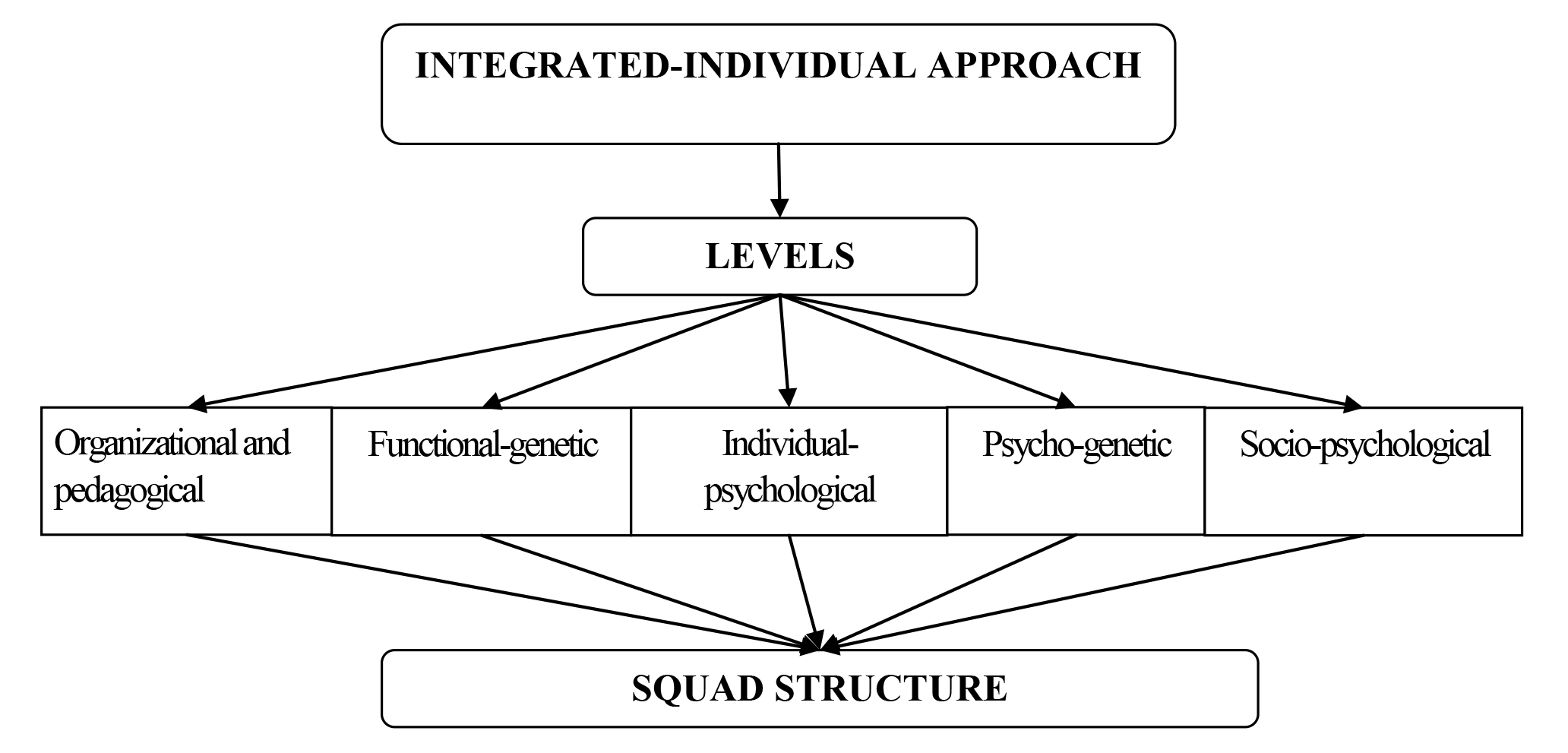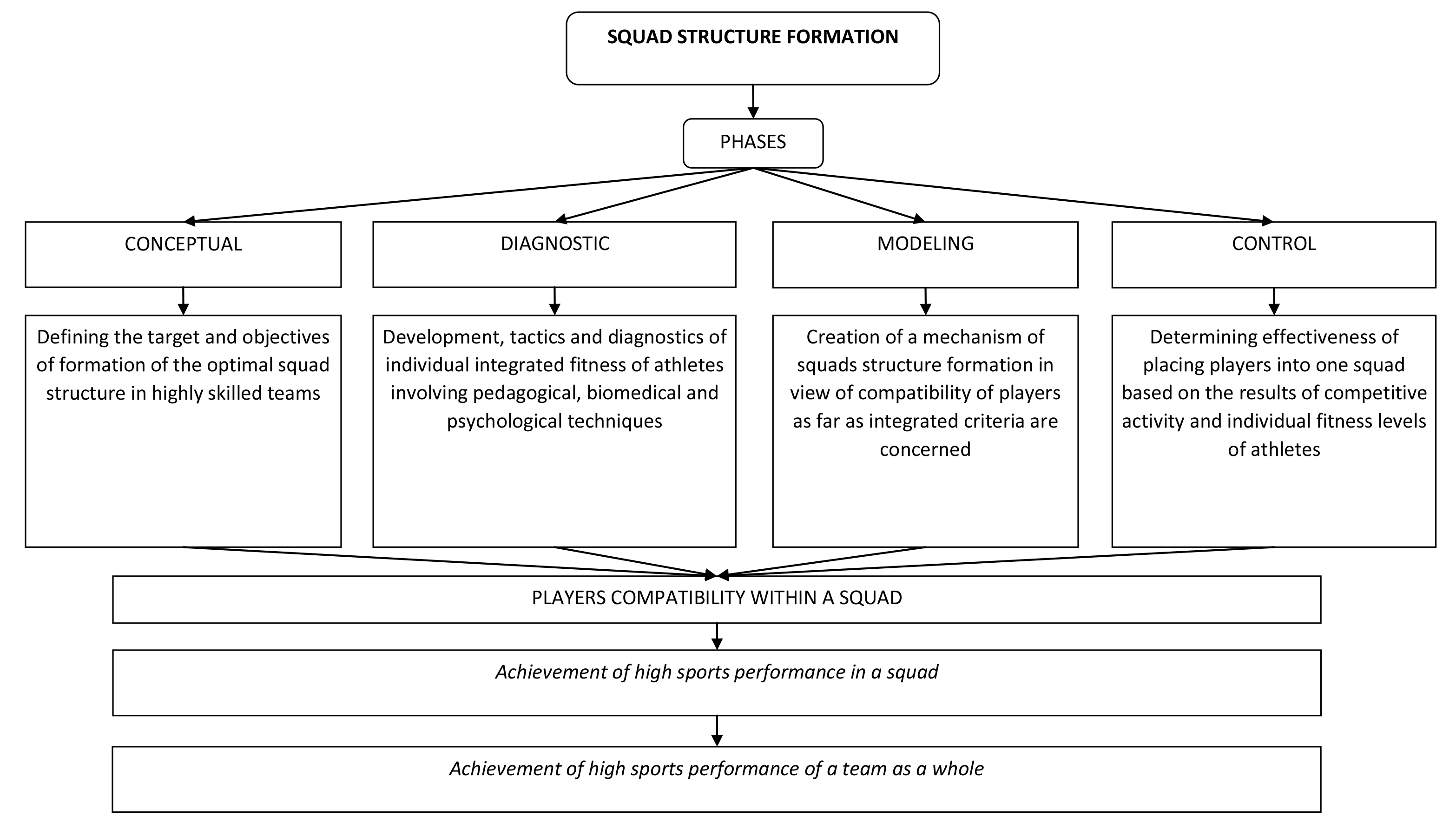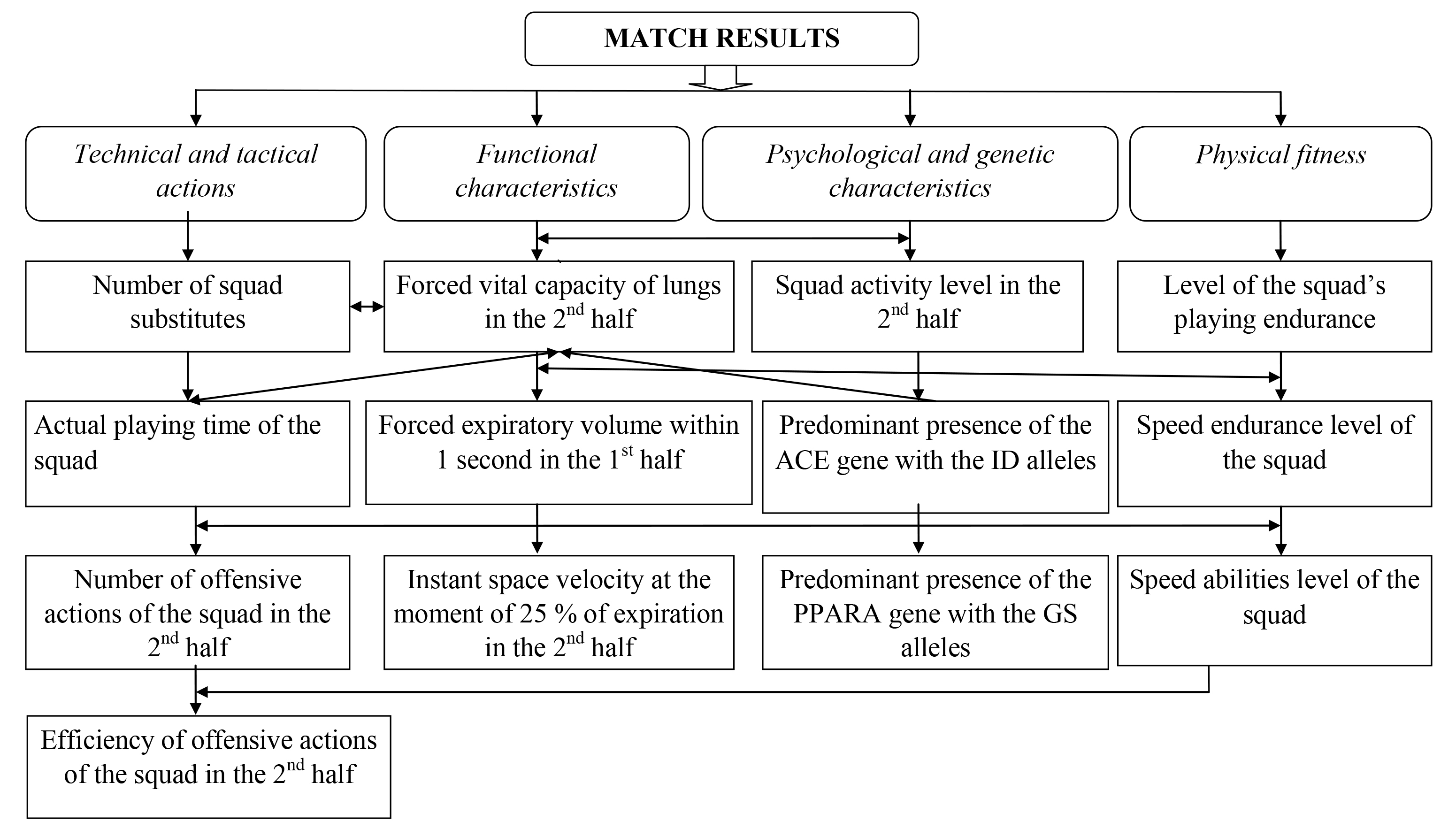Elite team competitive activity management concept in sports games
Фотографии:
ˑ:
Dr.Hab. G.A. Khrustalev
Vice-president of the Futsal Association of Russia, Dr.Hab., Professor, Honored Worker of Higher Education of the Russian Federation V.P. Guba
Moscow State Regional University, Moscow
Keywords: concept, management, modeling, competitive activity, sports games, integrated criteria, game squad.
Relevance. In team sports games including futsal, basketball and hockey competitive activity is a specially organized form of interaction of athletes where both individual players and the team as a whole can reveal their strengths that being developed and improved in the course of prolonged sports training [1, 2, 7, 10, 11, 15, 18, 19].
A number of leading experts [3-6, 8, 13, 14, 17] believe that in order for elite players to be reach peak athletic performance, along with the implementation of innovative scientific and methodological approaches to improvement of the sports training process it is quite important to develop and integrate an effective competitive activity management system.
The purpose of the work was theoretical development and experimental substantiation of the concept of management of elite teams' competitive activity in sports "without limitation" of the number of substitutes.
Materials and methods. The research was conducted in the period from 2008 to 2013. Elite hockey players (35 persons), basketball players (20 persons) and two futsal teams (26 persons) were involved.
Theoretical and methodological substantiation of the effectiveness of the concept of management of elite teams' competitive activity in games included rational manning of game squads based on individual compatibility of morphological and functional characteristics, integrated fitness as well as biochemical parameters and genetic markers of athletes. For this purpose a forming educational experiment was carried out involving 44 elite athletes of the first and youth line-ups of the teams of listed sports.
To test the effectiveness of the proposed model of squad formation in team sports two groups were organized: control group (CG) and experimental one (EG), of both first and youth line-ups.
The control group trained by the program for teams with elite sports skills, the experimental one, as well as the control one, trained by the program for teams with elite sports skills in their sport, but rational equilibrium distribution of players over all squads was used based on the modeling method taking into account individual morphological and functional characteristics, integrated fitness levels, biochemical parameters and genetic markers of athletes, supplementing and ensuring achievement of high sports performance in the course of competitive activity.
Research results and discussion. The conceptual framework of management of competitive activity in team sports is based on formation of the optimal structure of squads of elite teams, on the integrated-individual approach pioneered by B.M. Teplov [16] and V.S. Merlin [12].
Integrated-individual approach is characterized by an integrated structure of individual properties of a person: biochemical, physical, neurodynamic, etc.
Connection between all the properties of an individual is currently being studied in two ways: 1) knowledge of the individual's capabilities; 2) knowledge of the individual's properties.
Effective line-up of a sports team as a hierarchical level is always accounted for by the need to distinguish something typical, common for a certain group of people as well as something individually distinctive, unique, and inherent to only one person.
All this means, firstly, that psychophysiological dependence must be manifested by means of a specific mathematical apparatus applied to all multilevel connections.
Secondly, application of mathematical concepts within a systematic approach suggests that the issue of connection between hereditary and acquired individual properties is a special case of a more general problem of connection of individual properties of different levels. For example, the connection between the properties of a common type of nervous system and relationships of an individual is the connection of the hereditary and the acquired.
In our view, the basis of the integrated-individual approach to the formation of the line-up of squads of elite athletes is formed by its following levels: organizational and pedagogical, functional-genetic, individual-psychological, psycho-genetic and socio-psychological (Diagram 1).
Thus, it should be noted that pedagogical conditions of special integrated individuality of an athlete ensuring the comparability of the players within a social group - «a game squad» - should be used as the basis of effective formation of the squads in the sports we are currently studying.

Diagram 1. Structure of the integrated-individual approach when forming squad structure of elite teams
Development and implementation of the new technology of line-up formation of game squads of elite teams require the knowledge of the specifics of the process of modeling individual activity of the players.
Technological substantiation of the integrated system of line-up formation of game squads of elite teams can be divided into four phases (Diagram 2).
Conceptual phase – defining the targets and objectives of modeling game squads of elite teams. Within the framework of the developed concept priority areas of squads formation were designated, organizational and methodological framework for research of the data on identification of individual characteristics of athletes based on pedagogical, biomedical, psychological and sociological studies was created.

Diagram 2. Integrated system technology of structure formation of squads in elite teams
Diagnostic phase included development of a complex of scientific studies to determine the characteristics of integrated individuality of each athlete, identify his priority characteristics that provide for potential strengths of the player’s fitness [9]. The proposed program of studying individual characteristics of elite athletes proved to be highly efficient and stable in achieving results compared with the ones that existed before.
Modeling phase was based on creation of a mechanism of squads’ optimal structure formation in elite teams on the basis of individual compatibility of integrated fitness indicators of athletes. The concept of squad line-ups modeling was carried out based on the integrated-individual approach that includes organizational and pedagogical, functional-genetic, individual-psychological, psycho-genetic and socio-psychological levels.
Control phase was used to determine and assess the effectiveness of the three previous phases as well as to make adjustments in the course of training of athletes on the basis of line-up rotation and selection of the most compatible players within a game squad according to experts.
One of the main characteristics of increasing the efficiency of elite teams' competitive activity is revision of the teams manning system which first of all means modeling the game squads based on integrated individuality of athletes and their compatibility with players of other positions within a squad. This is accounted for by the current game requirements and the need to maintain a high pace of actions.
The scientific modeling method was used as basis while creating profiles of game squads’ line-ups in elite teams. So the most efficient comparability of players in small social groups can be determined and further development of an athlete within the system can be predicted.
As a result of inter-correlation and multifactor analyses of the studied fitness parameters of elite athletes specializing in the analyzed games we managed to model profiles of game squads which contribute to winning in a match.
Thus, the first squad of elite futsal teams should perform the same number of squad substitutes with the same values of its actual playing time throughout the game while in the process of implementation of technical and tactical actions (Diagram 3).
It should be emphasized that winning in a match is ensured if there are football players in the first game squad with high values of the number and efficiency of offensive actions in the 2nd half.
High values of forced vital capacity of lungs in the first game squad of futsal teams ensures high values of actual playing time of the squad and the number of changes throughout the match with a high level of physical performance.
Players of the first game squad are to have high values of the forced expiratory volume within 1 second in the 1st half and the instant space velocity at the moment of 25% of expiration in the 2nd half among their functional characteristics of the respiratory system.
High level of activity of the first squad players in the 2nd half contributes to achieving high values of the forced vital capacity of lungs, and vice versa.

Diagram 3. Profile of the first squad of elite futsal teams in view of the interconnection of the leading integrated characteristics
High levels of playing and speed endurance are also important in achievement of high sports performance by the first game squad, and they also define high values of the forced expiratory volume within 1 second in the 1st half. High values of the speed abilities increasingly ensure a large number and efficiency of offensive actions in the 2nd half.
Predominant presence of football players of the ACE and PPARA genes in the first game squad facilitates achievement of a high functional fitness level and high technical and tactical values.
The second game squad of an elite futsal team is to include players that have high values of efficiency of offensive and defensive actions in the 2nd half. It is possible to achieve top score in a match if actual playing time of all players of the second squad is optimized and in case of a large number of offensive actions in the 2nd half.
It is significant that high speed endurance level of the players of the second squad contributes to more intensive activity in the course of its actual playing time.
High values of the forced vital lung capacity of the players of the second game squad in the 2nd half ensure a large number of offensive actions during it, as well as complement the state of high activity in the match and reduce anxiety during the 2nd half. It was found that high values of speed and strength fitness level of the athletes of the second squad contribute to their achievement of top values of the forced vital lung capacity in the 2nd half.
Predominant presence of the II alleles of the ACE gene in the players of the second game squad ensures achievement of high values of efficiency of defensive actions in the 2nd half, as well as improved peak expiratory flow rate in it. Predominant presence of the CC alleles of the PPARA gene contributes to achievement of a high level of speed abilities.
It should be noted that low situational anxiety of the players of the second squad in the 2nd half ensures high efficiency of its offensive actions.
High values of the peak expiratory flow rate during the 2nd half ensure achievement of top values of efficiency of defensive actions of the squad.
For elite football players of the third game squad the crucial technical and tactical actions are high numbers of offensive and defensive actions of the squad in the 2nd half.
It is characteristic that the number of substitutes and actual playing time of the squad are largely determined by high values of forced vital capacity of lungs during the 2nd half.
It should be noted that high values of activity of the game squad in the 2nd half contribute to high rates of forced vital capacity of lungs in it. It is also noteworthy that if all the players have low values of the forced lung capacity in the 2nd half, situational anxiety of the third game squad in the 2nd half increases.
It was found that high values of the speed abilities level and speed endurance of the players of the third game squad ensure high rates of offensive and defensive actions of the football players in the 2nd half.
Predominant presence of the II alleles of the ACE gene and the LL alleles of the 5HTT gene in the players of the third game squad ensures achievement of a high level of speed endurance and speed abilities that in their turn determine competitive quantitative characteristics, the magnitude of which has an impact on the achievement of top sports performance during the match.
Conclusion. To achieve high competitive performance during official matches of both club and national teams in team sports "without limitation" of the number of substitutes it is necessary to carry out modeling of the line-ups of the game squads for the purpose of equilibrium distribution of players depending on the tasks set for the squads based on individual integrated fitness parameters ensuring high efficiency of actions by maintaining high pace of the game throughout the match.
The developed model profiles of play positions of elite teams (futsal, basketball, and hockey) are based on the conceptual framework of the integrated-individual approach, which is used to achieve good competitive performance. This fact was confirmed by the competition results.
The proposed approach has been shown to be highly effective in the training of the first and youth futsal teams. All this indicates that in the analyzed games athletes should be qualified at an early age based on the individual indicators of their fitness and this must be the basis for the formation of integrated play positions, without paying much attention to pre-play positions of athletes.
References
- Andreev, S.N. Analiz sorevnovatel'noy praktiki professional'nykh mini-futbol'nykh klubov (Analysis of competitive practice of professional futsal clubs) / S.N. Andreev, Ye.G. Aliev, K.V. Yeremenko // Uch. zapiski un-ta im. P.F. Lesgafta. – 2009. - №1 (47). – P. 3-6.
- Bal'sevich, V.K. Ocherki po vozrastnoy kineziologii cheloveka (Essays on human developmental kinesiology) / V.K. Bal'sevich. - Moscow: Sovetskiy sport, 2009. – 220 P.
- Gomel'skiy, A.Ya. Entsiklopediya basketbola ot Gomel'skogo (Gomel'skiy's Basketball Encyclopedia) / A.Ya. Gomel'skiy. – Moscow: Grand, 2002. – 352 P.
- Guba, V.P. Vybiraem vid sporta, kak natsional'nuyu ozdorovitel'nuyu i vospitatel'nuyu ideyu (Choosing sport as national health improving and educational idea) / V.P. Guba, G.A. Khrustalev // Teoriya i praktika fizicheskoy kul'tury. – 2013. – № 8. – P. 12.
- Guba, V.P. Individualizatsiya podgotovki yunykh sportsmenov: metodicheskoe izdanie (Individualization of junior athletes training: methodical edition) / V.P. Guba, V.G. Nikitushkin, P.V. Kvashuk. – Moscow: Sovetskiy Sport, 2009. – 275 P.
- Guba, V.P. Integral'nye osnovy sportivnoy trenirovki (metody otsenki i prognozirovaniya) (Integrated basics of sports training (methods of evaluation and prediction) / V.P. Guba // LAP LAMBEDT, Academic Publishing. – 2012. – 360 P.
- Guba, V.P. Osnovy sportivnoy podgotovki: metody otsenki i prognozirovaniya (morfobiomehanicheskiy podkhod) (Basics of sports training: methods of evaluation and prediction (morphobiomechanical approach) / V.P. Guba. – Moscow: Sovetskiy sport, 2012. – 384 P.
- Guba, V.P. Talant i kriticheskie tochki genotipa (Talent and turning-points of genotype) / V.P. Guba. – Moscow: Nauka i zhizn', 2013. – P. 33.
- Guba, V.P. Teoriya i praktika sportivnogo otbora i ranney orientatsii v vidy sporta: monografiya (Theory and practice of sports qualification and early guidance in sport: monograph) / V.P. Guba. – Moscow: Sovetskiy sport, 2008. – 304 P.
- Guba, V.P. Teoriya i metodika futbola: uchebnik dlya vuzov (Theory and methodology of football: textbook for higher education institutions) / V.P. Guba, A.V. Leksakov - Moscow: Sovetskiy sport, 2013. – 536 P.
- Krasnikov, A.A. Osnovy teorii sportivnykh sorevnovaniy: ucheb. posobie (Basics of theory of sports competitions: study guide) / A.A. Krasnikov. – Moscow: Fizicheskaya kul'tura, 2005. – 160 P.
- Merlin, V.S. Ocherk integral'nogo issledovaniya individual'nosti (Outline of integrated research of identity) / V.S. Merlin. – Moscow: Pedagogika, 1986. – 254 P.
- Mini-futbol (futzal): uchebnik (Indoor soccer (futsal): textbook) / Ed. by Ye.G. Aliev, S.N. Andreev, V.P. Guba. – Moscow: Sovetskiy sport, 2012. – 554 P.
- Portnov, Yu.M. Teoreticheskie i nauchno-metodicheskie osnovy podgotovki kvalifitsirovannykh sportsmenov v igrovykh vidakh sporta: avtoref. dis … dokt. ped. nauk (Theoretical, scientific and methodical basics of training of skilled athletes in team sports: abstract of doctoral thesis (Hab.) / Yu.M. Portnov. – Moscow, 1989. – 51 P.
- Tarasov, A.V. Sovershennoletie. Khokkey i khokkeisty (Pefection. Hockey and hockey players) / A.V. Tarasov. – Moscow: Molodaya gvardiya, 1970. – 352 P.
- Teplov, B.M. Problemy individual'nykh razlichiy (Problems of individual distinctions) / B.M. Teplov. – Moscow, 1961. – 536 P.
- Khrustalev, G.A. Modelirovanie sostava igrovykh zven'ev vysokokvalifitsirovannykh komand v sportivnykh igrakh (bez ogranicheniya kolichestva zamen) (Modeling of structure of game positions in elite sports teams (without restriction of number of substitutes) / G.A. Khrustalev. – Moscow: Sportivnaya kniga, 2012. – 138 P.
- Khrustalev, G.A. Teoretiko-metodicheskoe obosnovanie profiley sostava igrovykh zven'ev vysokokvalifitsirovannykh komand (Theoretical-methodological justification of profiles in the structure of game positions in elite teams) / G.A. Khrustalev // Teoriya i praktika fizicheskoy kul'tury. – 2012. – № 9. – P. 34–37.
- Shustin, B.N. Modelirovanie v sporte (teoreticheskie osnovy i prakticheskaya realizatsiya): dis … d-ra ped. nauk v vide doklada (Modeling in sport (theoretical bases and practical implementation): doctoral thesis (Hab.) in the form of report) / B.N. Shustin. – Moscow, 1995. – 82 P.
Corresponding author: fkgv@shu.ru




